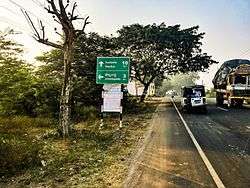Jonnalagadda, Guntur district
Jonnalagadda is a village in Guntur district of the Indian state of Andhra Pradesh. It is located in Guntur East mandal of Guntur revenue division. It is 12 km away from Guntur. Due to its proximity to the town the village boasts of many educated people. Jonnalagadda is a politically active village and the first Assembly Speaker of Andhra Pradesh, Mr Nallapati Venkata Ramaiah comes from this village. Jonnalagadda is a perfect village with soils suitable to grow rice and rainfed crops, and dairy, temples, Kalyana Mandapam (contributed by TTD), schools and Pharma and engineering colleges. There are 7 temples in the village i.e. Sai baba temple, Vinayaka temple, Venugopala swamy temple, Anjeneya swamy temple, Sivalayam, Poleramma temple and Gangamma temple besides Boddurai where prayers are offered on special occasions. As per the inscription available at the premises, the Venugopala swamy temple was constructed by a chieftain of Kakatiya Rudramadevi, in reciprocation to the comfortable treatment for his army during one of his endeavours by the then village chief Sri Jonnalagadda Verri Ragaiah. It has been renovated since then. Sai baba temple, though recent, has gained importance among the residents of Jonnalagada as well as Narasaroapet. It has become a custom to celebrate Sai baba Thirunala (fair) every year on May 18. It is a huge festival in Jonnalagada. Many people from different places, from near and far, participate in the proceedings on that day. Four famous engineering colleges are there near the village. Every sankranthi festival is celebrated by conducting sports, games and yedla pandalu (bull racing), in which many people from nearby villages also take part and enjoy. Every festival is celebrated with pomp and show. One of the major festivals is Vinayaka chavithi. Children enjoy identifying and collecting herbs for puja, preparing Ganesh idols with clay, performing puja and immersing the God in Kuppagunji vagu. Occasionally, Poleramma and Gangamma jataras are performed. Jonnalagadda stands as an example for communal amity with a church (since 1952) and a mosque. Christmas and Ramjan are celebrated with equal fervor. Jonnalagadda has a satellite village, Rangareddy Palem. Jonnalagadda village also stands as a mute witness to the exploitation of colonial British, with 3 pairs of abandoned Neelimandu bavulu (wells) used for processing blue, cultivation of which must have rendered many fertile lands useless. These wells still can be seen behind Poleramma temple. [4][2]
Jonnalagadda | |
|---|---|
Village | |
 Jonnalagadda_Signboard_on_Amaravati_road | |
.svg.png) Jonnalagadda Location in Andhra Pradesh, India | |
| Coordinates: 16.3438°N 80.4410°E | |
| Country | India |
| State | Andhra Pradesh |
| District | Guntur |
| Suburban | Guntur |
| Government | |
| • Type | Panchayati raj |
| • Body | Jonnalagadda gram panchayat |
| Area | |
| • Total | 917 ha (2,266 acres) |
| Population (2011)[3] | |
| • Total | 4,847 |
| • Density | 530/km2 (1,400/sq mi) |
| Languages | |
| • Official | Telugu |
| Time zone | UTC+5:30 (IST) |
| PIN | 522034 |
| Area code(s) | +91–863 |
| Vehicle registration | AP |
Geography
Chinapalakaluru is situated to the north of the district headquarters, Guntur,[5] at 16.3438°N 80.4410°E. It is spread over an area of 917 ha (2,270 acres).[2]
Governance
Jonnalagadda gram panchayat is the local self-government of the village.[1] It is divided into wards and each ward is represented by a ward member.[6] The village forms a part of Andhra Pradesh Capital Region and is under the jurisdiction of APCRDA.[7]
Education
As per the school information report for the academic year 2018–19, the village has a total of 4 schools. These are 1 private and 4 Zilla/Mandal Parishad schools.[8]
See also
References
- "Gram Panchayat Identification Codes" (PDF). Saakshar Bharat Mission. National Informatics Centre. p. 102. Archived from the original (PDF) on 18 August 2017. Retrieved 7 May 2019.
- "District Census Hand Book : Guntur (Part B)" (PDF). Census of India. Directorate of Census Operations, Andhra Pradesh. 2011. pp. 14, 384. Retrieved 2 June 2019.
- "Population". Census of India. Registrar General and Census Commissioner of India. Retrieved 9 May 2019.
- India, The Hans (31 March 2018). "Guntur urban divided into east, East mandals". www.thehansindia.com. Guntur. Retrieved 26 April 2019.
- "District Census Handbook : Guntur (Part A)" (PDF). Census of India. Directorate of Census Operations, Andhra Pradesh. 2011. pp. 5, 602–603. Retrieved 4 June 2019.
- Seetharam, Mukkavilli (1 January 1990). Citizen Participation in Rural Development. Mittal Publications. p. 34. ISBN 9788170992271.
- "Declaration of A.P. Capital Region" (PDF). Andhra Pradesh Capital Region Development Authority. Municipal Administration and Urban Development Department, Andhra Pradesh. 30 December 2014. p. 4. Archived (PDF) from the original on 11 May 2019. Retrieved 14 May 2019.
- "School Information". Commissionerate of School Education. Government of Andhra Pradesh. Retrieved 7 May 2019.